United States Armory and Arsenal at Harpers Ferry
Introduction
Text-to-speech Audio
The United States Armory and Arsenal at Harpers Ferry, often called the Harpers Ferry Armory, was a series of facilities used for the manufacture and storage of firearms for the United States government from around 1802 to the start of the Civil War in 1861. Chosen by George Washington as one of two locations for a federal armory, it produced a variety of guns and became the primary driving force of Harpers Ferry’s economy. In 1859, the armory was seized by John Brown and his followers as part of their attempt to instigate a slave uprising. When the Civil War began in 1861, the facilities were destroyed as both Union troops and Confederates fought for control of the town. Never rebuilt, the site of the armory is today mostly covered by railroad tracks.
Images
Depiction of some of the armory buildings. Courtesy of the Harpers Ferry-Bolivar Historic Town Foundation.
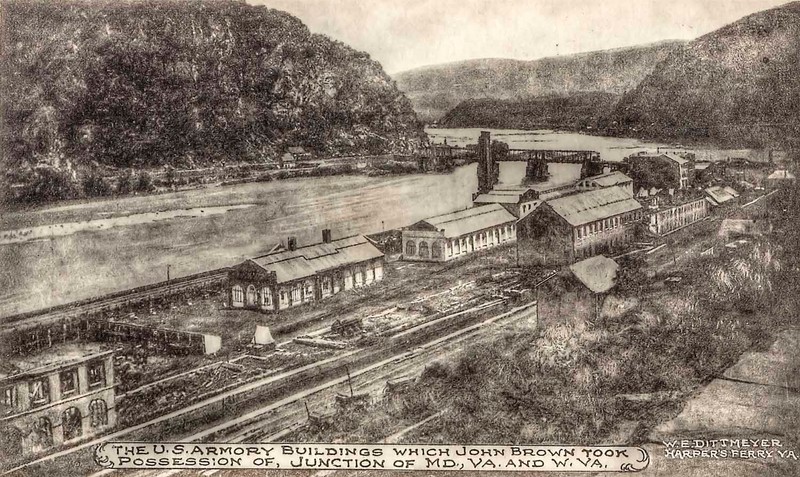
Artist rendering of the Arsenal and Armory buildings
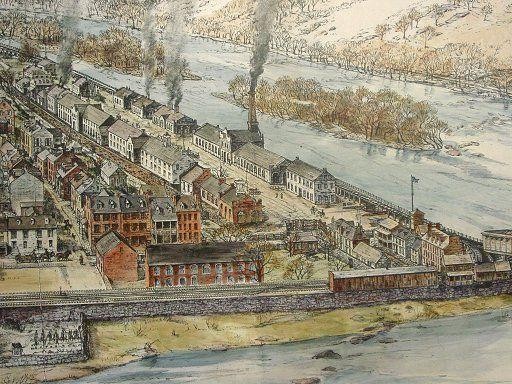
This map depicts the location of the Harpers Ferry Armory, as well as the arsenal and rifle works. Image obtained from the West Virginia Division of Culture and History.
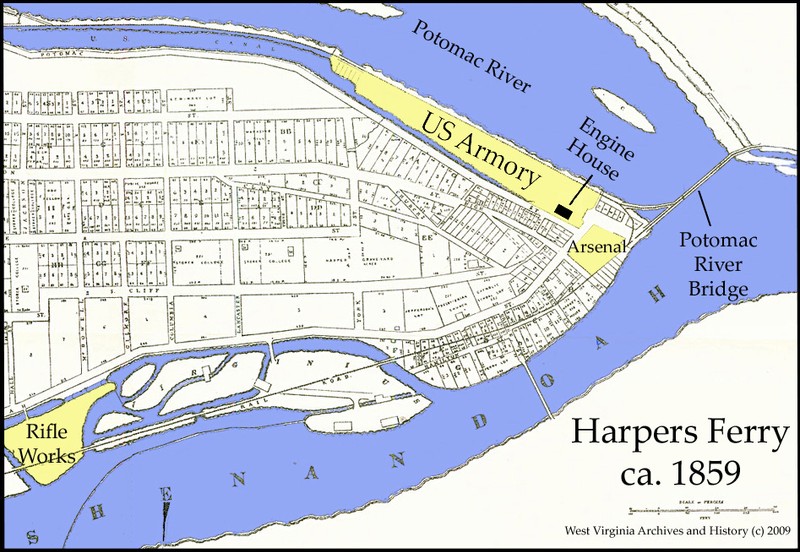
Locations of the two arsenal buildings and some armory buildings, from the Historical Base Map, 1859.
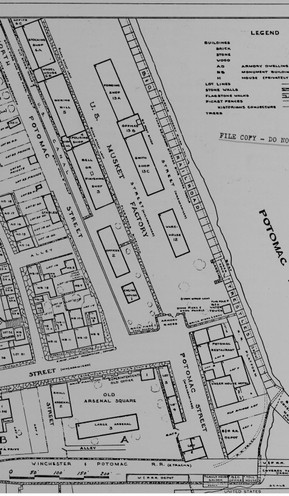
Harpers Ferry Armory, c. 1820
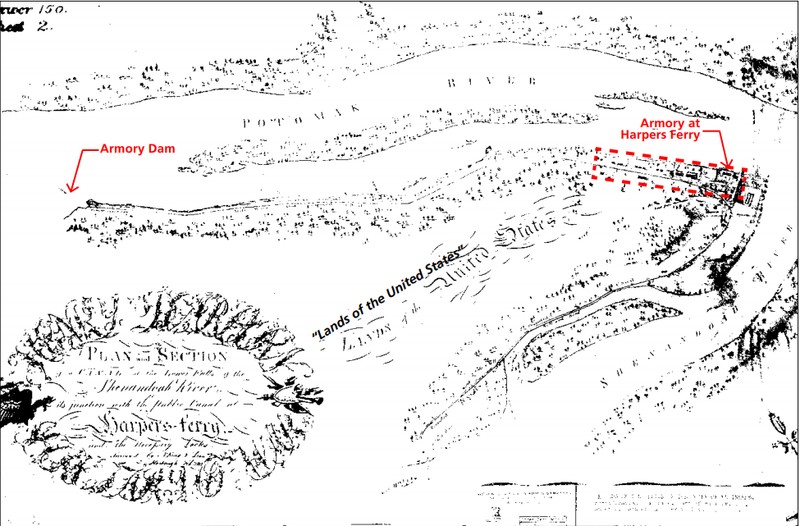
"Harpers Ferry Armory workshops and dwelling houses along the banks of the Potomac River, circa 1824." (Maryland Historical Society)
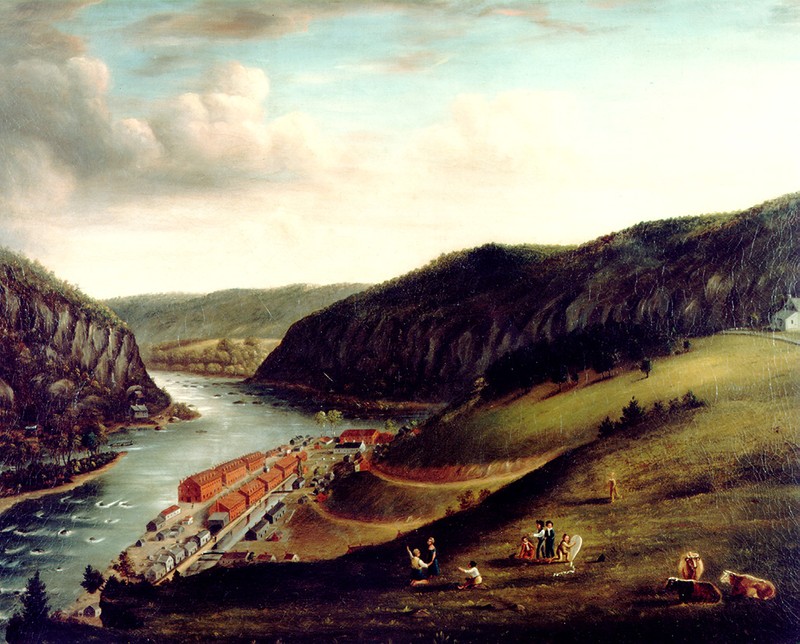
Image of the 1857 Armory with buildings identified
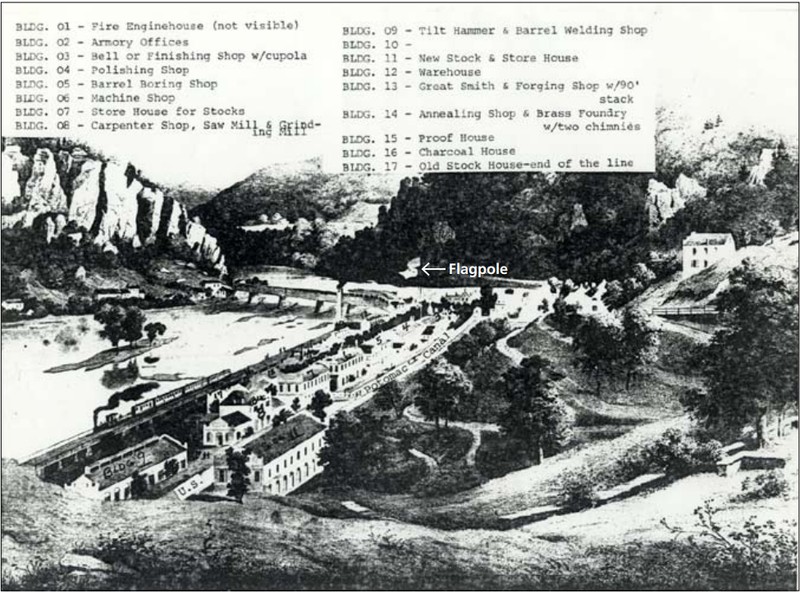
The burning of Harpers Ferry Armory in 1861. Courtesy of West Virginia and Regional History Center, WVU Libraries.
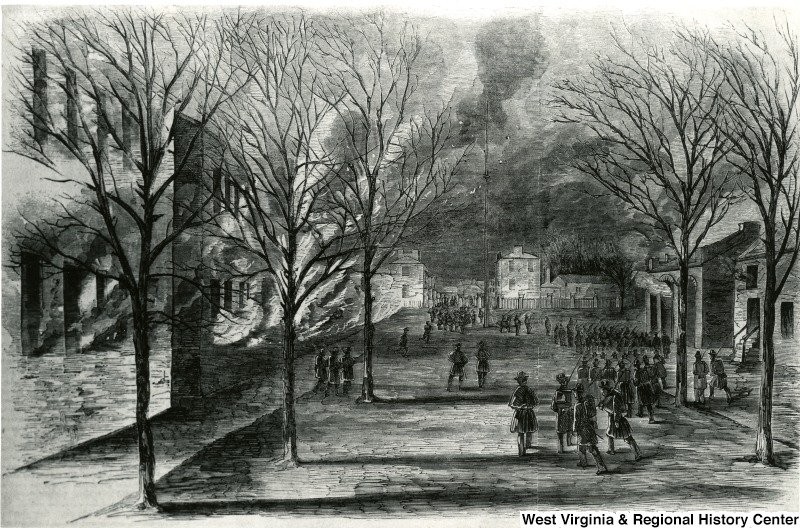
The B & O railroad bridge ruins (destroyed by Confederate troops in June 1861) with the armory buildings visible in the background.
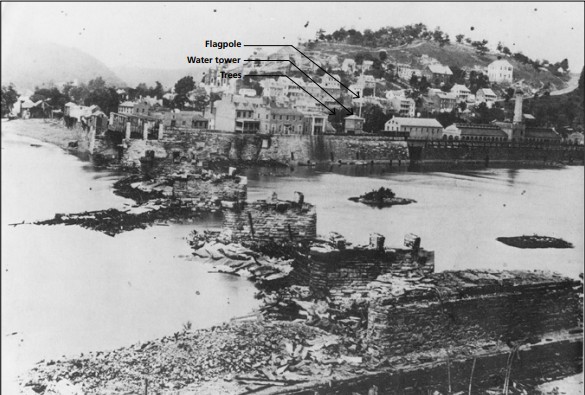
"This c.1862 photograph shows the main entrance to the Harpers Ferry Armory. The “fire engine and guard house” (John Brown’s Fort) is the first building on the left as you enter the Armory Grounds. (HF-27, Historic Photo Collection, Harpers Ferry NHP)"
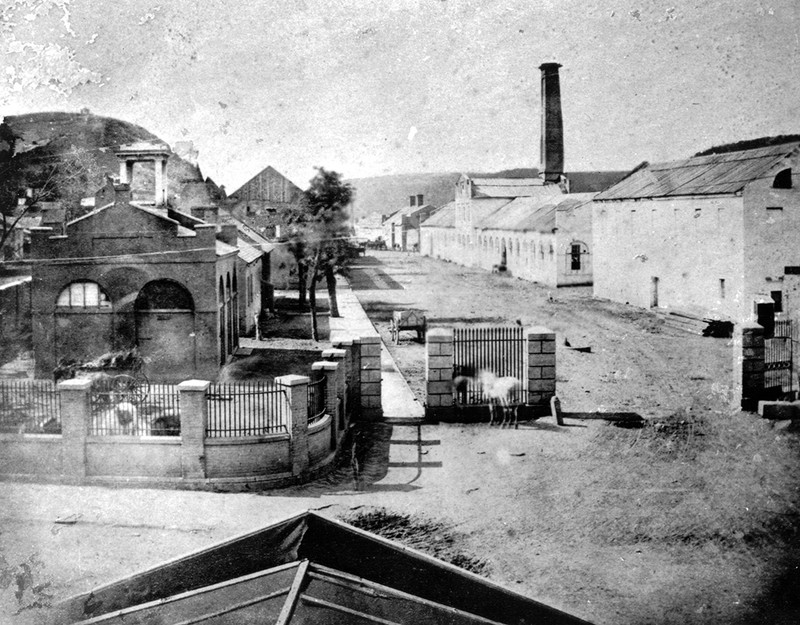
"This 1862 photo from the Mathew Brady collection shows the ruins of the burned out Armory workshops between the Musket Factory headrace (right) and Potomac River. A Union pontoon bridge is under construction across the river. (HF-30, Historic Photo Collection, Harpers Ferry NHP)"
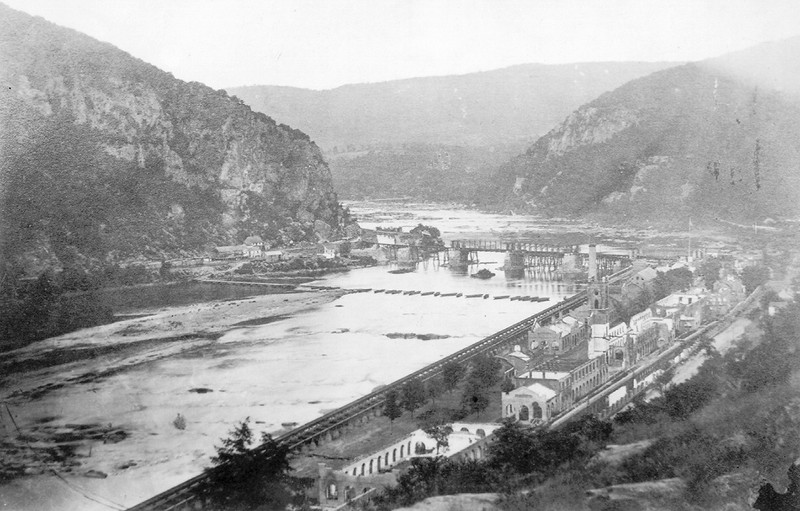
"Ruins of the Armory Rolling Mill, photographed by Silas A. Holmes in October 1862. The mill housed two tilt-hammers, two reverberatory furnaces, one forge, two train of rollers, and a set of large shears used to roll “scrap iron into bars of suitable sizes for use in the shops.” (LC-B8171-0655 DLC, Library of Congress)"
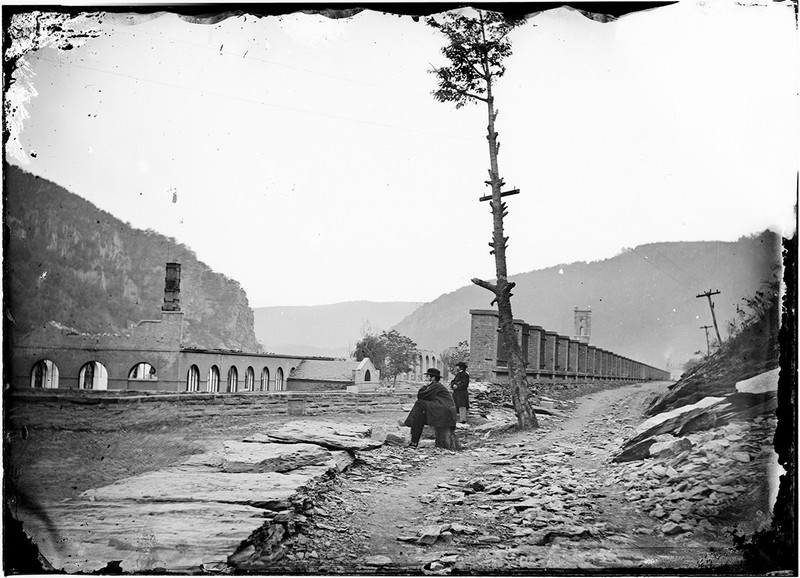
"Musket Factory buildings rehabilitated for use as a Union quartermaster depot during Maj. Gen. Philip Sheridan’s 1864 Shenandoah Valley campaign. (HF-619, Historic Photo Collection, Harpers Ferry NHP)"
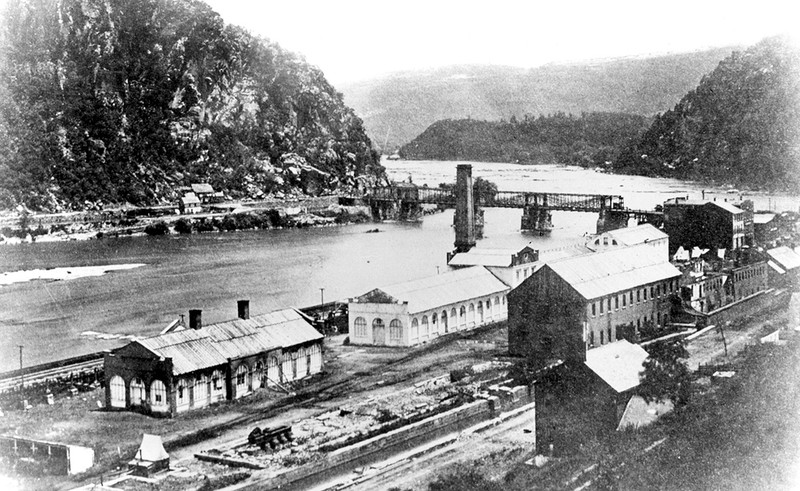
"Musket Factory ruins and new Bollman iron bridge spans across the Potomac River, photographed by Alexander Gardner in July 1865. (165-SB-26, National Archives)"
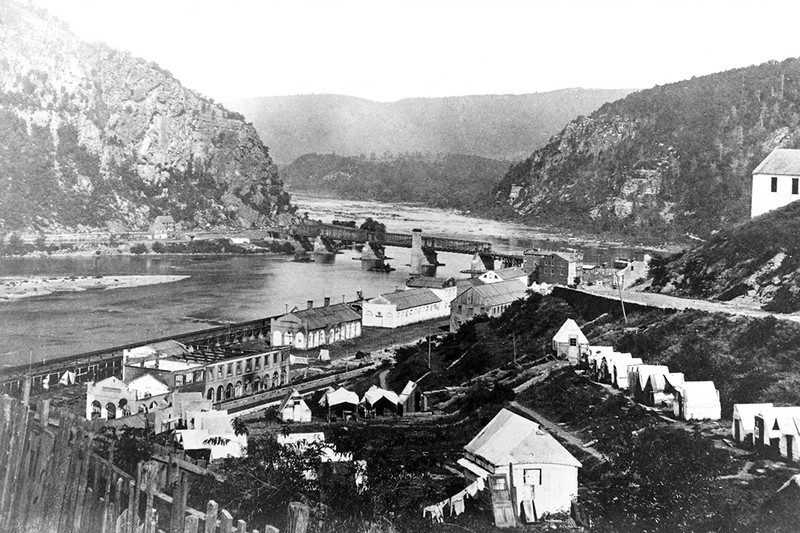
Musket Factory site in 1868, after the end of the Civil War.
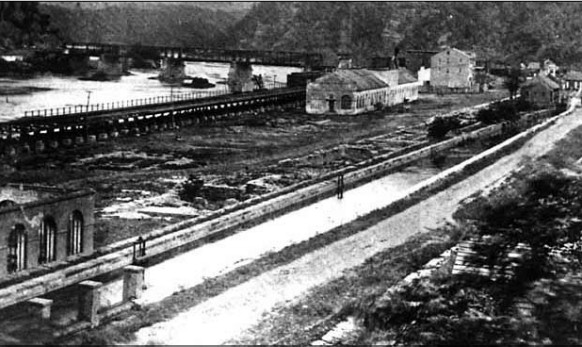
"Ruins of the Armory Smith and Forging Shop in 1870. The Baltimore & Ohio Railroad’s new Bollman Bridge across the Potomac River has been completed. (HF-45, Historic Photo Collection, Harpers Ferry NHP)"
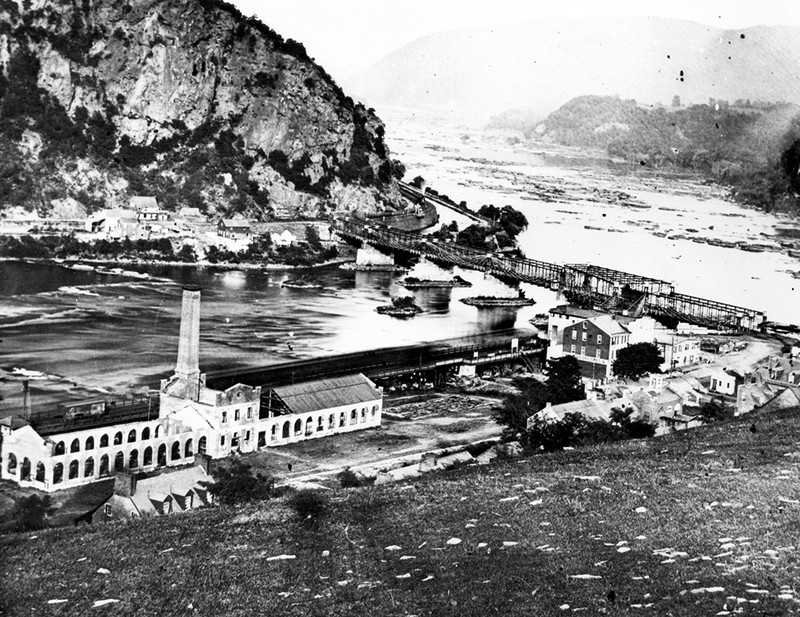
"Another view of the Armory Smith and Forging Shop ruins during a photography session on May 29, 1886. The furnace stack, erected in 1846, was 90 feet tall, 10 feet square at its base, and situated on top of a “massive stone arch thrown across a tail race leading from one of the water wheels.” (HF-785, Historic Photo Collection, Harpers Ferry NHP)"
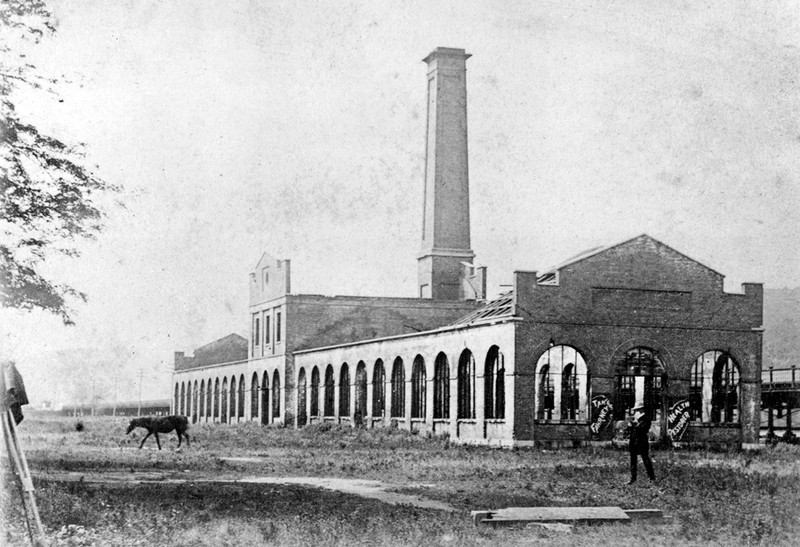
"Circa 1889 photo of the old Armory Grounds looking northwest, with John Brown’s Fort on the left. The new Harpers Ferry Paper Company mill, erected between 1888-1890, sits at the upstream end of the grounds. The furnace stack on the right is the last remnant of the old Smith and Forging Shop. (HF-1237, Historic Photo Collection, Harpers Ferry NHP)"
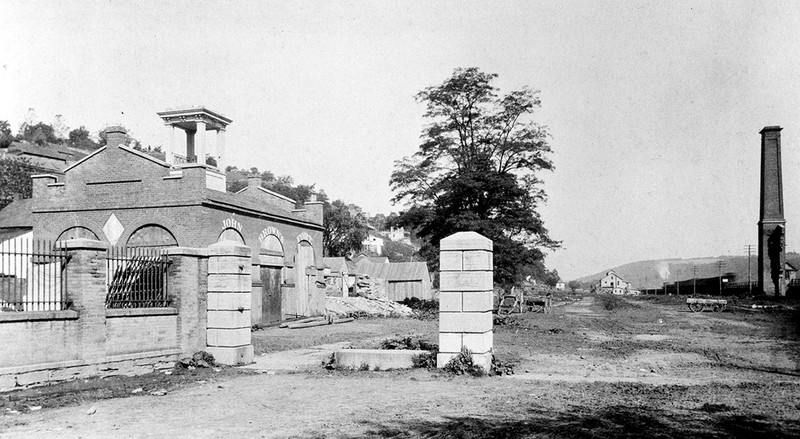
"Remains of a wooden “Backshot Water Wheel, 15 feet diameter, 10 feet wide.” The water wheel and large masonry wheel pit, located between the Boring Shop and Stocking Shop, were completed in 1846. (HF-1727, Historic Photo Collection, Harpers Ferry NHP)"
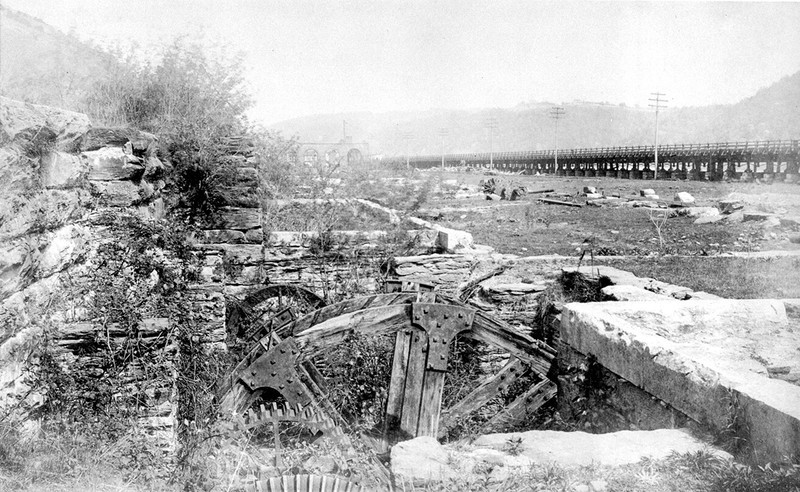
By 1896 the B & O Railroad had changed the course of their tracks (the old trestle along the river is visible in this photo) and only foundations were visible at the Armory site.
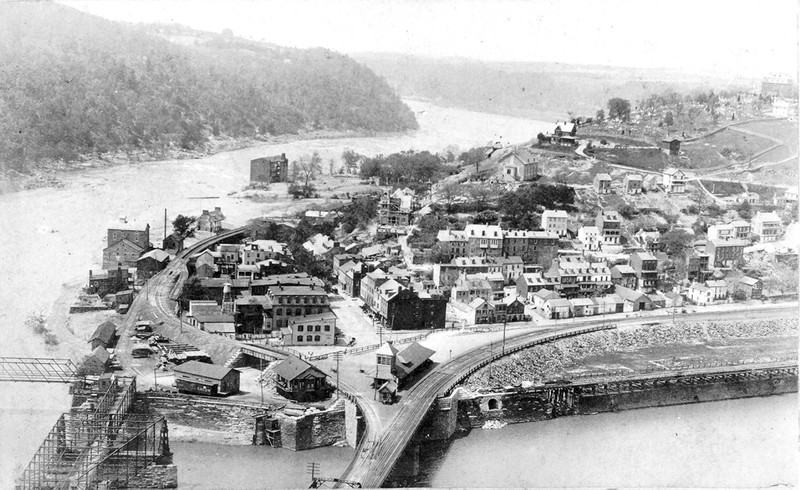
The engine house, also known as John Brown's Fort, is the only surviving structure from the armory. Image obtained from the National Park Service.
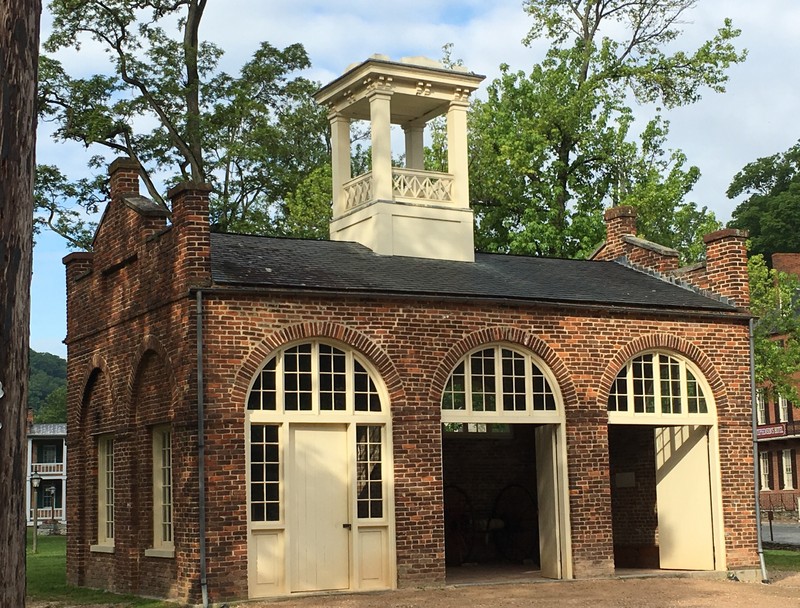
U.S. Armory, c. 1820
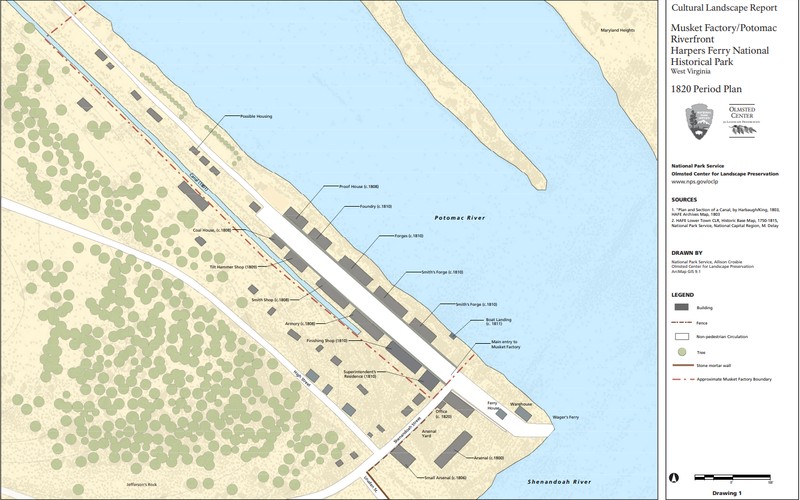
U.S. Armory, c. 1840

U.S. Armory, c. 1860
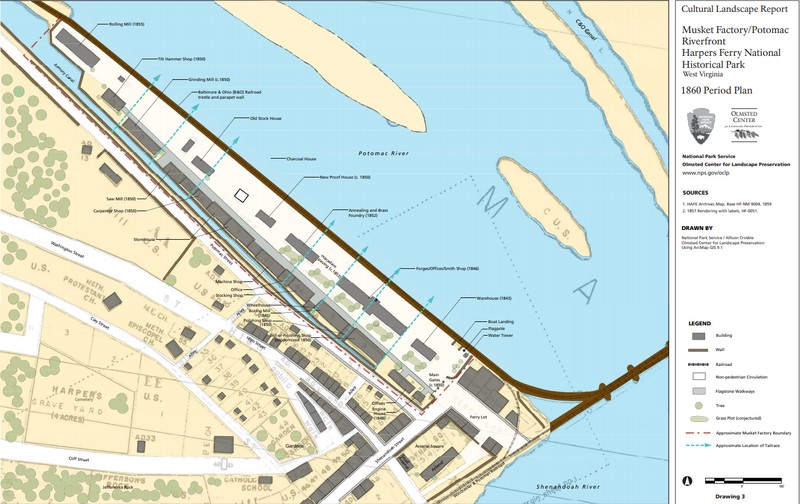
U.S. Armory, 1869
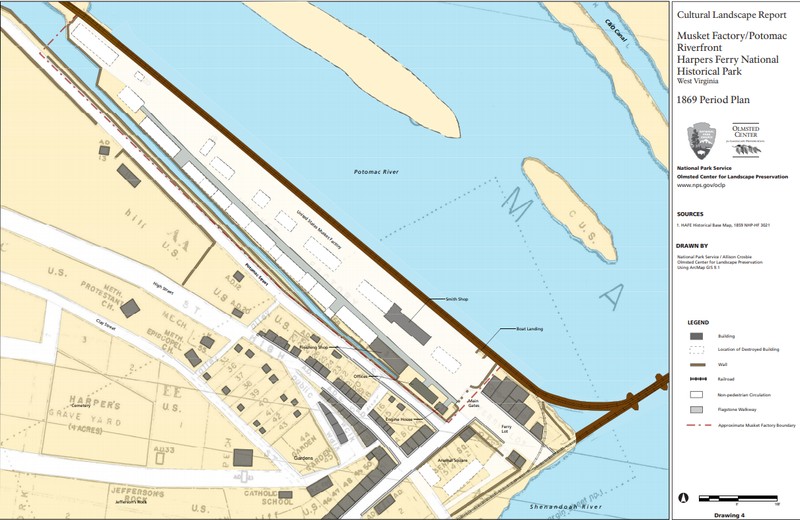
U.S. Armory site, 1944
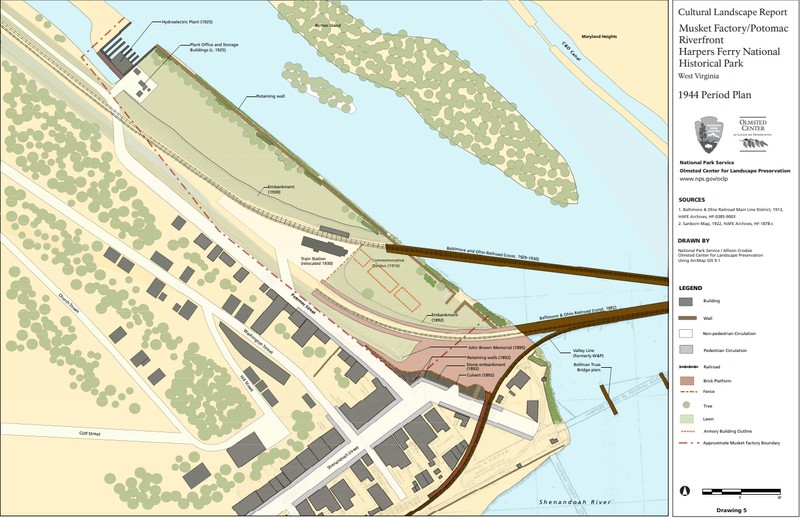
U.S. Armory site, current conditions
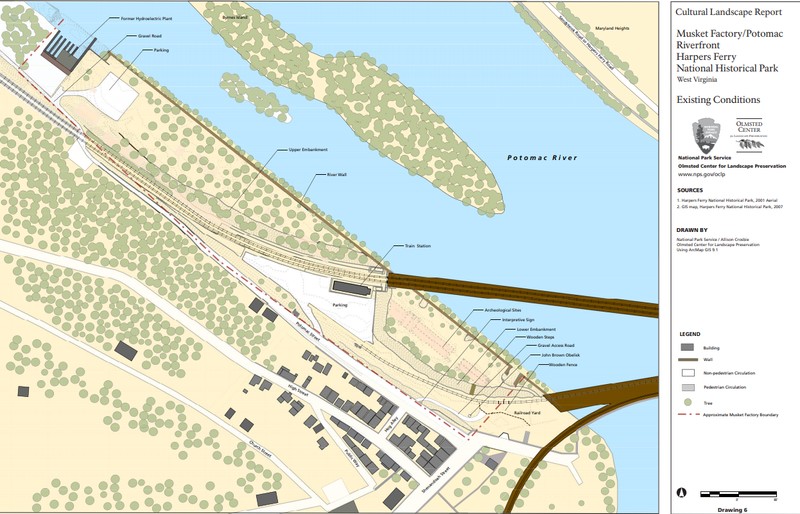
Gunsmithing equipment on display at Harpers Ferry National Historical Park.
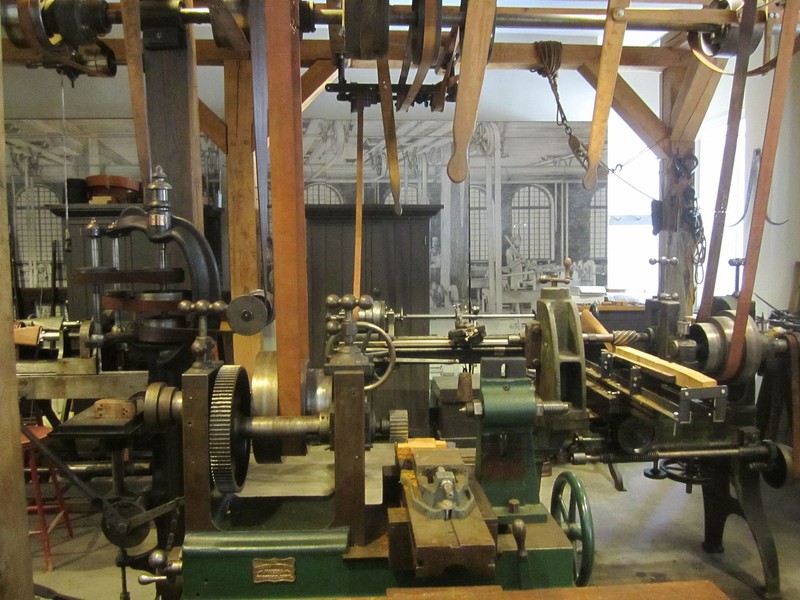
The foundations of two arsenal buildings have been outlined to give an idea of how large the structures were. Image obtained from TripAdvisor.
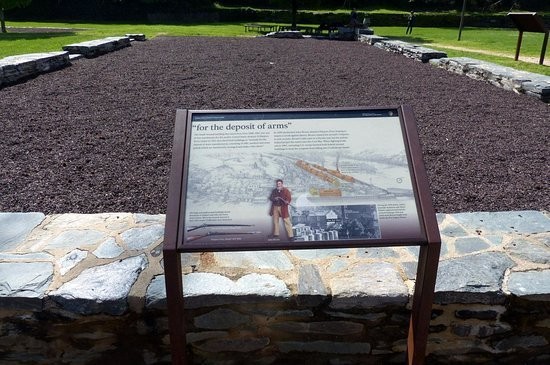
Backstory and Context
Text-to-speech Audio
In the early years of the United States, all firearms issued to the military were either obtained from private manufacturers or imported from abroad. In 1794, Congress passed a bill mandating the establishment of national arsenals and armories. George Washington was given authority to determine how many to build and where. He ultimately chose two locations: Springfield, Massachusetts, and the rural town of Harpers Ferry in what is now West Virginia. Washington chose Springfield because it already had the infrastructure in place to support an armory; he chose Harpers Ferry because it was relatively close to Washington D.C., yet far enough inland to be secure from foreign invasion. The government was reluctant to accept Harpers Ferry due to its isolation and the high cost of building an armory there, but Washington insisted. The government purchased 125 acres of land from the descendants of Robert Harper in 1796 but construction of the armory did not begin until 1799. It originally consisted of several workshops, a canal, and a mill to harness waterpower for the machinery.
Full-scale production of arms began in 1802 with a workforce of 25 men. The armory was plagued with problems from the start. While it manufactured a wider variety of muskets, rifles, and pistols than its counterpart in Springfield, it still made fewer firearms overall and at a higher cost; while Springfield could manufacture 15,000 a year, Harpers Ferry only managed an average of 10,000 annually. Mismanagement, lack of sufficient waterpower, neglect, and problems adapting to new advances in gun manufacturing took its toll on the facility. By 1844, inspections found the armory in a dilapidated condition and it was soon decided to completely renovate it. From 1845 to 1854 the armory underwent extensive reconstruction. Changes included the addition of twenty-five new structures and seven workshops: the installation of 121 new machines, the enlargement of the canal to utilize more water power, and a more functional integration of the facilities to boost efficiency. The number of workers grew to 400.
In 1859, the armory became the target of John Brown’s raid, throwing Harpers Ferry into the national spotlight. Brown, a radical abolitionist and an instigator of the Bleeding Kansas conflict, planned on distributing weapons from the armory to local slaves with the intent on creating a widespread insurrection to end slavery. On the night of October 16, Brown and a small band of followers managed to capture the armory. However, the anticipated slave uprising did not materialize and the raiders were soon surrounded. On the morning of October 18, a company of U.S. Marines under the command of Col. Robert E. Lee stormed the engine house, where the raiders had barricaded themselves, and quickly captured the survivors. In all, seventeen people were killed, six of which being civilians. John Brown was later tried and executed in Charles Town. The armory was slightly damaged but soon resumed production.
As the Civil War broke out in 1861, Harpers Ferry soon became a place of contention due to its strategic location and the presence of the federal armory. On April 17, 1861 Virginia voted to secede from the Union, and several companies of militiamen were immediately dispatched to seize the armory. At the time Harpers Ferry was only guarded by Lt. Roger Jones and a force of 65 men. Knowing he was badly outnumbered, Jones ordered the torching of the armory before retreating on April 18. Although 15,000 arms and a few buildings were destroyed, local citizens managed to extinguish the flames before further damage could be done. When the Confederates arrived they seized the surviving weapons and began shipping the machinery to the armory in Richmond. On June 14, Confederate forces under Col. Joseph E. Johnston, fearful that Union forces would retake the town, burned the armory and withdrew. Two weeks later a group of Confederate raiders returned and destroyed the surviving remains. Harpers Ferry would change hands numerous times over the course of the war.
The armory was never rebuilt after the Civil War ended. The only structure to survive was the engine house that John Brown used as a fort during his raid, which stands 150 feet from its original location after being moved several times. Today, most of the site where the armory once stood is now covered by railroad embankments. The foundations of two arsenal buildings have been outlined and together with the engine house make up Arsenal Square.
Descriptions of some of the Armory structures from the 1980 National Register of Historic Places Nomination for Harpers Ferry National Historical Park:
Lumber House and Coal Bin (Historical Base Map Bldg. 10): “at the west end of the Musket Factory yard, was designed by Maj. John Symington and erected c. 1848. The two-story building measuring 55’8” by 78’ had a stone first story, a brick second story, and a slate roof. The first floor was used for coal storage and the second floor served for the storage of lumber. The second floor windows had wooden frames and blinds for air circulation. Confederate soldiers burned the structure on June 14, 1861, and the ruined walls were leveled after 1884. Subsurface foundation remains may be present.”
Warehouse (Bldg. No. 12): “was designed by Maj. Henry K. Craig and erected in 1844-45 at the eastern end of the Musket Factory yard. The two-story brick building had stone foundations, a flagstone floor, and a slate roof and measured 93’6” by 30’10”. It was used for the storage of iron, steel, and other supplies. Confederate troops bring the building on June 14, 1861. After reroofing its walls in 1864, the Union Quartermaster and Commissary Departments used it as a warehouse through the rest of the war. The ruined walls were leveled between 1884 and 1886, but the stone foundations are still visible.”
Smith and Forging Shop (Bldg. No. 13): “designed by Maj. John Symington, was a three-part building with overall dimensions of 280’ by 35-1/2’. The forging shop, the west wing, and the center offices were built in 1845-46; the smith shop, the east wing, was added in 1847-48 next to the warehouse described above. The shops were brick on stone foundations with brick and flagstone floors, cast iron door and window frames, and sheet iron roofs. The one-story forging shop measured 122’ by 35-1/2’, the one-story smith shop measured 121’ by 35-1/2’, and the two-story center measured 46’ by 37’. In the middle of the back (riverside) wall of the center building was the main chimney stack, 90’ high, 10 feet square at the base, and six feet square at the top. The stack was built upon a massive stone arch thrown across a tail race from the canal in the factory yard. In 1852 ventilators were installed along the lengths of the roofs of the wings. Confederate troops burned the buildings on June 14, 1861. The brick walls were reroofed so that the building could serve as a warehouse for the Quartermaster and Commissary Departments of the Union Army during 1864-65. The walls were leveled between 1889 and 1896, but the stone foundations of about three-quarters of the building are still visible. The remainder of the site is outside the authorized park boundary and its now occupied by the Baltimore and Ohio Railroad Station at Harpers Ferry.”
Rolling Mill: (Bldg. No. 18): “designed by Maj. John Symington, was erected by Col Benjamin Huger and Maj. William H. Bell in 1852-55 over an outlet of the power canal at the west end of the Musket Factory yard. The 146’-by’45’ one-story brick building was 16-1/2’ high on stone foundations and had a flagstone floor, water wheels, cast iron door and window frames, and a slate roof. There were two stacks 45’ and 40’ high. The Confederates burned the structure on June 14, 1861, but most of the machinery was left intact. The building was reroofed and used as a pulp mill by the Savery Company after 1889. About three-fourths of the original length of the structure still stands, and it has most recently functioned as an electric power generating station.
B & O stone wall: “In 1840-43 the Baltimore and Ohio Railroad Company erected a massive stone wall along the Potomac River bank side of the Musket Factory yard. It was 1380’ long, 15’ high above the low water level, and 4-1/2’ thick. It contained eight culverts for the tail races from the Armory workshops. The wall was built 20’ out from a similar river wall built by the Armory in 1837-39, which had also been constructed some 20’ out from the previously existing shoreline and filled in behind. Portions of the second wall are still present. The railroad originally ran on an iron trestle above and behind this wall; it was moved inland to its present alignment in 1892-93.”
Potomac Canal: “carried water from the Armory’s Potomac Dam inland parallel to the south bank of the river to supply power to the Musket Factory shops. It was reconstructed and enlarged between 1830 and 1837, and between 1854 and 1860 both sides from above the Rolling Mill down through the factory yard were lined with cut stone walls six feet high and 4-1/2’ thick. The lower portion of the canal from the Rolling Mill east was filled in and covered with a railroad siding along much of its course in 1892-92 (sic).” The upper portion from the dam to the Rolling Mill, a distance of about a mile, is intact and has functioned to power the electrical generators in the former mill. It is walled with dry-laid stone.”
Cite This Entry
Appalachian Studies Association et. al. "United States Armory and Arsenal at Harpers Ferry." Clio: Your Guide to History. October 15, 2021. Accessed March 21, 2025. https://theclio.com/entry/31681
Sources
Crosbie, Allison A., and Andrew S. Lee. Cultural Landscape Report For The United States Armory At Harpers Ferry And Potomac Riverfront. Boston, MA: National Park Service, 2009.
"National Register of Historical Places Inventory--Nomination Form: Harpers Ferry National Historical Park." Accessed August 10, 2021. http://www.wvculture.org/shpo/nr/pdf/jefferson/66000041.pdf.
Smith, Merritt Roe. Harpers Ferry Armory and the New Technology: The Challenge of Change. London: Cornell University Press, 1977.
Bob O'Connor. "Harpers Ferry is the land the government keeps buying." Spirit of Jefferson. August 5, 2015. Accessed August 10, 2021. http://www.spiritofjefferson.com/news/opinion/article_48ac320e-3afe-11e5-99cb-db79a9fa9308.html.
"Harpers Ferry Historical Base Map, 1859, Part of the Master Plan, Harpers Ferry National Historical Park." Accessed August 10, 2021. http://npshistory.com/publications/hafe/map-1859.pdf.
"Cultural Landscape Report for the Historic United States Armory Site/Potomac Riverfront." National Park Service. Accessed August 10, 2021. http://npshistory.com/publications/hafe/armory_clr.pdf
"Armory Grounds." Dave Gilbert Graphic Design. Accessed August 10, 2021. http://www.dgilbert53.net/?page_id=581.
"Cultural Landscape Report for the Historic United States Armory Site/Potomac Riverfront." National Park Service. Accessed August 10, 2021. http://npshistory.com/publications/hafe/armory_clr.pdf
"Cultural Landscape Report for the Historic United States Armory Site/Potomac Riverfront." National Park Service. Accessed August 10, 2021. http://npshistory.com/publications/hafe/armory_clr.pdf
"Armory Grounds." Dave Gilbert Graphic Design. Accessed August 10, 2021. http://www.dgilbert53.net/?page_id=581.
"Armory Grounds." Dave Gilbert Graphic Design. Accessed August 10, 2021. http://www.dgilbert53.net/?page_id=581.
"Armory Grounds." Dave Gilbert Graphic Design. Accessed August 10, 2021. http://www.dgilbert53.net/?page_id=581.
"Armory Grounds." Dave Gilbert Graphic Design. Accessed August 10, 2021. http://www.dgilbert53.net/?page_id=581.
"Armory Grounds." Dave Gilbert Graphic Design. Accessed August 10, 2021. http://www.dgilbert53.net/?page_id=581.
"Cultural Landscape Report for the Historic United States Armory Site/Potomac Riverfront." National Park Service. Accessed August 10, 2021. http://npshistory.com/publications/hafe/armory_clr.pdf
"Armory Grounds." Dave Gilbert Graphic Design. Accessed August 10, 2021. http://www.dgilbert53.net/?page_id=581.
"Armory Grounds." Dave Gilbert Graphic Design. Accessed August 10, 2021. http://www.dgilbert53.net/?page_id=581.
"Armory Grounds." Dave Gilbert Graphic Design. Accessed August 10, 2021. http://www.dgilbert53.net/?page_id=581.
"Armory Grounds." Dave Gilbert Graphic Design. Accessed August 10, 2021. http://www.dgilbert53.net/?page_id=581.
"Cotton Factory." Dave Gilbert Graphic Design. Accessed August 10, 2021. http://www.dgilbert53.net/?page_id=826.
"Cultural Landscape Report for the Historic United States Armory Site/Potomac Riverfront." National Park Service. Accessed August 10, 2021. http://npshistory.com/publications/hafe/armory_clr.pdf
"Cultural Landscape Report for the Historic United States Armory Site/Potomac Riverfront." National Park Service. Accessed August 10, 2021. http://npshistory.com/publications/hafe/armory_clr.pdf
"Cultural Landscape Report for the Historic United States Armory Site/Potomac Riverfront." National Park Service. Accessed August 10, 2021. http://npshistory.com/publications/hafe/armory_clr.pdf
"Cultural Landscape Report for the Historic United States Armory Site/Potomac Riverfront." National Park Service. Accessed August 10, 2021. http://npshistory.com/publications/hafe/armory_clr.pdf
"Cultural Landscape Report for the Historic United States Armory Site/Potomac Riverfront." National Park Service. Accessed August 10, 2021. http://npshistory.com/publications/hafe/armory_clr.pdf
"Cultural Landscape Report for the Historic United States Armory Site/Potomac Riverfront." National Park Service. Accessed August 10, 2021. http://npshistory.com/publications/hafe/armory_clr.pdf

